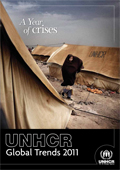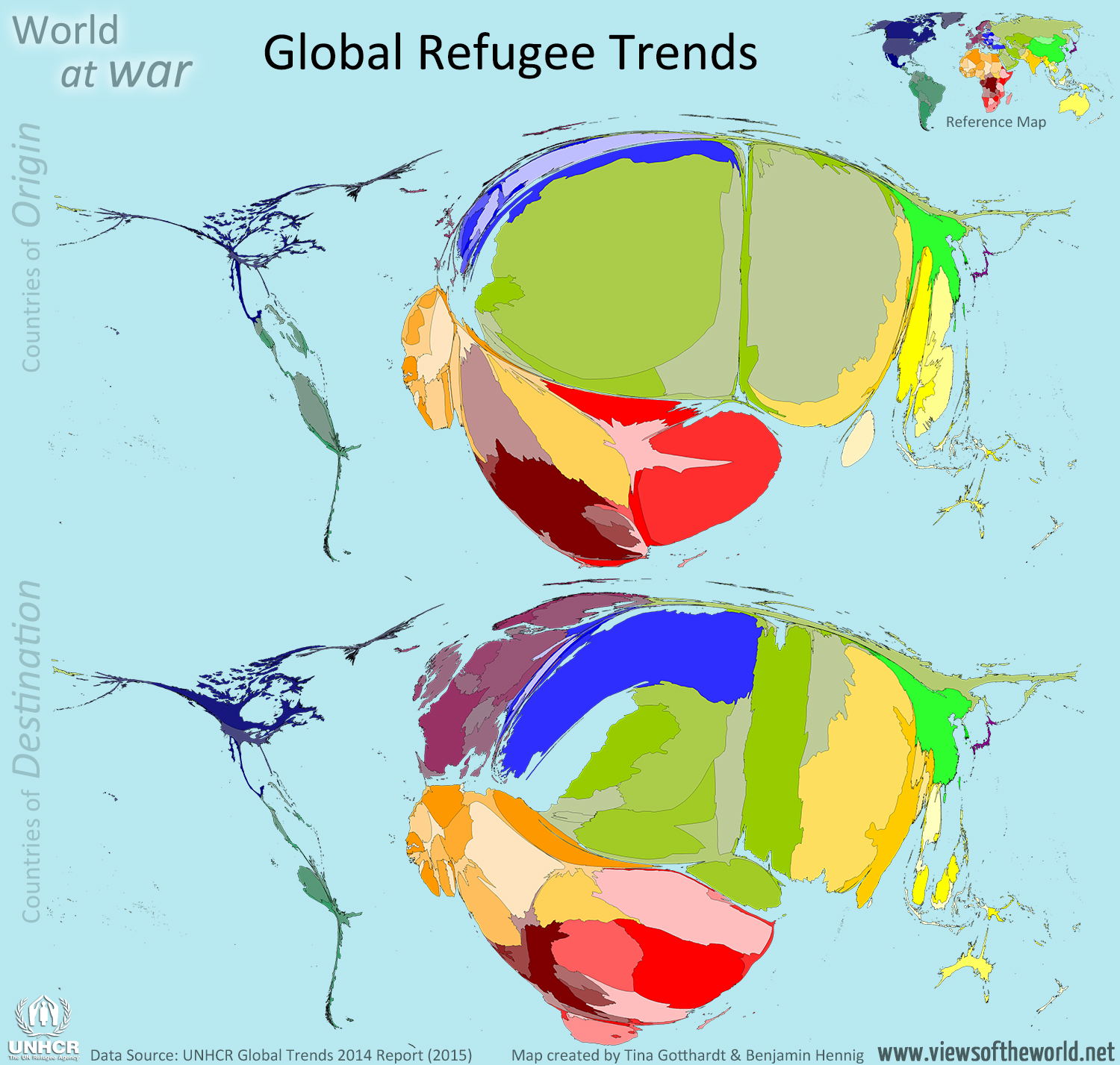1,321,560 persons have applied for asylum in the European Union in 2015 according to Eurostat. Eurostat defines an asylum applicant as “a person having submitted an application for international protection or having been included in such application as a family member during the reference period”. This is not the number of granted asylum claims, neither does it mean that this is a figure for first-time applicants but includes all claims having been made in that year.
The spatial patterns for these figures are very different than those arriving as refugees on the shores of the Mediterranean (see here for 2015), as are the number of asylum claims in the past year. The following two cartograms put these figures into their spatial context by providing two different ways of interpreting the data. The first map is a cartogram where countries of the European Union are resized according to the total number of asylum applicants in the past year (all countries having more than 50,000 applications are labelled in that map). The second map shows this in relative proportions drawn on a population cartogram. Here the basemap shows the EU countries resized according to their total population, i.e. providing an impression of each country’s population share, and indicates the relative number of asylum seekers measured in asylum applications per 1 million population:
Tag Archives: crisis
Asylum seekers in Europe 2014/15
2,500 people are believed to have died or gone missing on their way to Europe this year already, according to estimates by UNHCR. But it was the image of a young boy found dead on the shores of Turkey which changed the tone in the debate about the ongoing refugee crisis in Europe. While the response to the crisis varies strongly, Campaign groups are calling for a European-wide approach to the crisis. While Germany suspended the Dublin regulation to allow regugees into the country and claim asylum regardless of where they entered the European Union, the country also calls for a more equitable system of sharing refugees across the EU similar to Germany’s domestic approach of distributing refugees.
The following cartogram shows the current situation in Europe using Eurostat’s latest statistics about the number of asylum applicants in each country. The data covers the first half of 2015 (January to June) and adds up to 417,430 officially recorded claims in that period in the EU member states. The following map also includes those European countries which are not member of the European Union but part of the Schengen area and it shows each country resized according to the absolute number of asylum applications in that country from January to June 2015:
Refugees in Germany
As stated in a report earlier this year, “wars, conflict and persecution have forced more people than at any other time since records began to flee their homes and seek refuge and safety elsewhere” (see more details and a global map series at http://www.viewsoftheworld.net/?p=4541). In Europe, this has lead to a human crisis with many refugees seeking to get to the continent via sea and land. Beyond the human tragedy, the political debate has become ever more heated over who is willing to host the migrants.
Unlike the debate in the UK, where the government is more concerned about closing the borders into Britain at the most vulnerable entry point in France, Germany’s government is looking into ways how an expected 800,000 migrants can be accommodated this year. Using data from the most recent official statistics the following cartogram shows where refugees and asylum seekers are allocated in Germany showing the states (or Laender) rezised according to the absolute number of asylum seekers and refugees living there (the colours merely distinguish the different Laender and do not represent any further data):
World at war: Global refugee trends
 The UNHCR Global Trends 2014 Report released earlier this week by the UN High Commissioner for Refugees finds that “wars, conflict and persecution have forced more people than at any other time since records began to flee their homes and seek refuge and safety elsewhere“.
The UNHCR Global Trends 2014 Report released earlier this week by the UN High Commissioner for Refugees finds that “wars, conflict and persecution have forced more people than at any other time since records began to flee their homes and seek refuge and safety elsewhere“.
Commemorating World Refugee Day, UN High Commissioner for Refugees António Guterres declared in a statement that “around the world, almost 60 million have been displaced by conflict and persecution. Nearly 20 million of them are refugees, and more than half are children. Their numbers are growing and accelerating, every single day, on every continent.” But while the ‘western’ media takes an often embarrassingly western-centric view, and European politicians struggling to find solutions to this global crisis, the report also shows how big this human crisis really has become.
The following two cartograms show the most recent picture of global refugee trends in 2014 as published in the 2015 UNHCR report. The two maps use the total numbers for ‘refugees and people in refugee-like situations’ according to their country of origin and destination and resizes each country according to its absolute number of refugees. Excluded in these maps are those refugees whose origin is unknown or who are stateless or cannot be assigned to a specific country:
European Youth Unemployment: A lost generation?
As shown previously on this website, unequal living conditions are one of the defining social problems of contemporary crisis-battered Europe. This weekend I attended the RondaForum 2014, Southern Europe’s forum on entrepreneurship and education, where this issue was discussed amongst young people from around the world who were seeking for new ideas to bridge the gap between the often bleak realities of Europe’s youth and the aspirations that are needed to create a sustainable basis for future competitiveness and growth. How big that problem really is amongst Europe’s youth can be seen from a look at the change in youth unemployment over the course of the financial crisis. Much of Europe’s youth is now being referred to as the lost generation, and in almost every European country youth unemployment has increased considerably between 2007 and 2012, as the following two maps show. They show the countries of Europe resized according to their absolute increase/decline in youth unemployment in these five years, with only Germany having a significant decline in youth employment in that period. Amongst those countries having a considerable increase, especially Southern Europe is standing out showing the growing North-South divide of the continent that highlight the challenges that initiatives such as the European Union’s Europe 2020 growth strategy face:
A year of crises: Global refugee trends
 “A report released by the UN High Commissioner for Refugees shows 2011 to have been a record year for forced displacement across borders, with more people becoming refugees than at any time since 2000. UNHCR’s ‘Global Trends 2011’ report details for the first time the extent of forced displacement from a string of major humanitarian crises that began in late 2010 in Côte d’Ivoire, and was quickly followed by others in Libya, Somalia, Sudan and elsewhere. In all, 4.3 million people were newly displaced, with a full 800,000 of these fleeing their countries and becoming refugees.” (Quoted from the UNHCR Press Release)
“A report released by the UN High Commissioner for Refugees shows 2011 to have been a record year for forced displacement across borders, with more people becoming refugees than at any time since 2000. UNHCR’s ‘Global Trends 2011’ report details for the first time the extent of forced displacement from a string of major humanitarian crises that began in late 2010 in Côte d’Ivoire, and was quickly followed by others in Libya, Somalia, Sudan and elsewhere. In all, 4.3 million people were newly displaced, with a full 800,000 of these fleeing their countries and becoming refugees.” (Quoted from the UNHCR Press Release)
In the Worldmapper project we have mapped refugees before (see the maps of refugee origins and destinations) but these maps are far more outdated than most material that we have on Worldmapper. Not only provides the new report a comprehensive updated series of data, but also are refugee numbers of an extremely changing nature as they do not follow general mid- or long-term trends (such as changes in population or carbon emissions). As the introductory statement indicates, humanitarian crises and other hardly predictable events can result in changing refugee patterns.
The following two maps show the updated picture of refugee trends in 2011 as published in the UNHCR report this week (which also saw the commemoration of World Refugee Day “dedicated to raising awareness of the situation of refugees throughout the world“. The two maps use the total numbers for ‘refugees and people in refugee-like situations’ according to their country of origin and destination. Excluded in these maps are those refugees whose origin is unknown or who are stateless:






